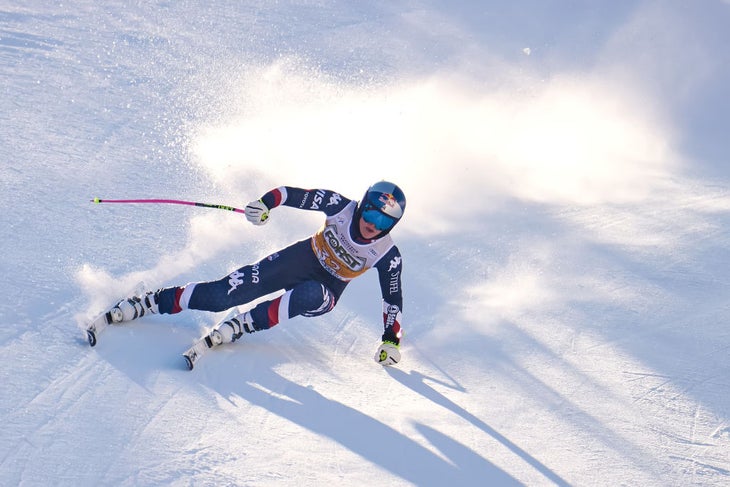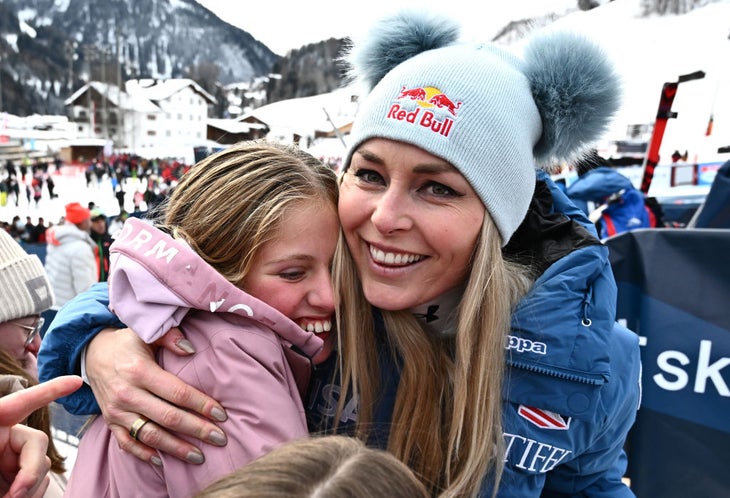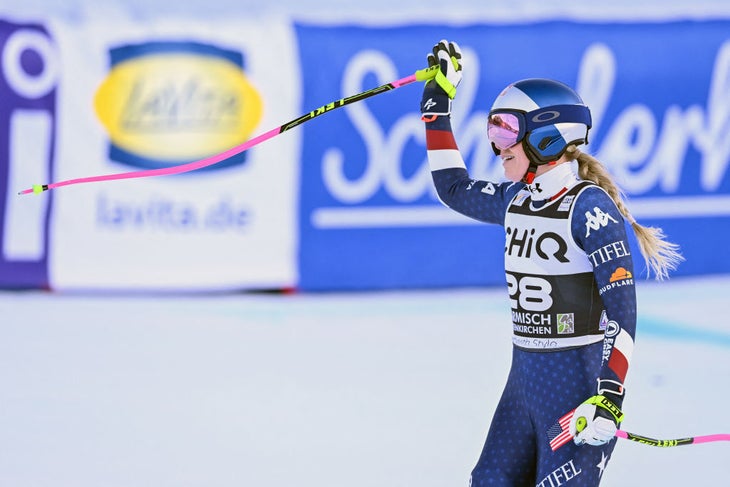When Lindsey Vonn announced her return to the U.S. Ski Team this past November, alpine racing fans were stunned. In 2024 Vonn turned 40 and also underwent a partial knee replacement. There is no precedent for a downhill ski racer to return to the World Cup circuit at that age, with an artificial joint. A comeback like Vonn’s is by and large unprecedented—in any professional sport.
But some of Vonn’s colleagues on the US Ski Team weren’t so surprised.
“When you’re an elite athlete at the level that Lindsey was, ski racing is just a part of your character, it’s in your blood,” Tom Kelly, a long-time spokesperson for the U.S. Ski Team who has known Vonn since she was a junior racer, told Outside. “You get great satisfaction being in your competitive field, in her case, being out on snow. She didn’t want to retire when she did. She just couldn’t do it anymore. And now she can.”
Here’s what to know about Vonn’s comeback:
Why Did Lindsey Vonn Retire?
Vonn’s career on the ski racing World Cup circuit began in 2000. She excelled in the speed events: downhill and its more technical cousin, super-G. Over her 19-year professional career, she won more combined downhill and super-G races (71) than any other ski racer, male or female, in history.

Along the way, Vonn became American ski racing’s first celebrity to attain mainstream fame. She graced the cover of major magazines, was a guest on the Tonight Show, and yes, even dated golfer Tiger Woods.
But Vonn also suffered a litany of serious injuries throughout her career. One of the worst came during 2013 world championships in Schladming, Austria, when she crashed in the super-G and tore multiple ligaments in her knee and suffered a tibial plateau fracture. Although she would eventually recover, and go on win another 23 World Cups and an Olympic bronze medal, Vonn was never truly the same. She has said that she suffered regular knee pain after that injury.
On February 10, 2019, Vonn announced her retirement shortly after earning her eighth world championship medal, a bronze in downhill. She was “broken beyond repair,” she said at the time. She had hoped to catch Ingemar Stenmark’s record 86 World Cup wins—a mark since surpassed by Mikaela Shiffrin, who stands at 99—but ended her career with 82 wins. Vonn has said she was devastated to miss the goal, but her body “was telling her to stop.”
Vonn said that she was unable to fully straighten her right leg for several years, which caused additional problems in her hip, back, and neck. “I ended on good terms—it wasn’t perfect but it was still my terms,” she recently told NBC Sports.
How Did Vonn Return to Ski Racing?
Only a handful of elite athletes have returned to professional sports after undergoing a major joint replacement: Bo Jackson came back to baseball after undergoing a hip replacement in 1993, and tennis star Andy Murray did so after a hip resurfacing in 2019. But no one has done so in ski racing.
Last April, Vonn had a lateral uni-compartment knee arthroplasty on her right knee—medical-speak for a partial knee replacement. Doctors removed a small section of bone and replaced it with titanium alloy.
Vonn had the operation to address the knee pain that nagged her in her daily life—not so that she could return to competition. “I’d go on a hike with my friend’s seven-year-old and Aunt Lindsey has to take a break after ten minutes,” she told NBC News.
But the operation exceeded even her wildest dreams. A few months later, Vonn returned to the gym. At first, she had to retrain her nervous system and musculature, which for years had compensated for pain.
“You have to retrain your body to say, ‘yes, I can bend my ankle or knee or hip the way I used to before I had this pain,’” explains Tyler White, a certified athletic trainer at iSport in Killington, Vermont, who has helped athletes return to skiing with joint replacements. “This neuro-patterning is time consuming. You have to be diligent and consistent.”
But Vonn said that after the surgery, she could do exercises and drills in the gym that she hadn’t been able to do in eight years. She played tennis and lifted weights without pain. Over the ensuing months, Vonn regained strength, and in August she traveled to New Zealand to try skiing. That’s when ski racing fans began to think that she might return to the sport.
“With this new knee that is now a part of me… I feel like a whole new chapter of my life is unfolding before my eyes,” she posted on Instagram from New Zealand, concluding, “I don’t know exactly what lies ahead, but I know I’m healthy, happy and grateful.”
Shortly after her 40th birthday in October, Vonn traveled to Sölden, Austria, to do her first actual competition training. She felt good, and in November announced her plans to return. Just eight months after surgery, she skied down the women’s downhill and super-G courses at the Beaver Creek World Cup in Colorado—not racing, but at full speed. Her times would not count, but she would be racing full-length World Cup courses near race pace. Her finishing time would have placed her inside the top-20.
“The replacement went so well, and I have no pain and no swelling,” Vonn told reporters at Beaver Creek. “It feels so amazing to be back. I can’t tell you how big a difference it makes to be able to ski without pain. It’s a completely new world for me. I haven’t felt this good in 15 years.”
“It was the happiest I had seen her in years,” says Kelly.
Can Vonn’s New Knee Survive Ski Racing?
But are partial knee replacements designed for the forces imparted by ski racing?
“We don’t really know,” says Dr. Melbourne Boynton, long-time U.S. Ski Team physician, knee surgeon, and medical director of the Vermont Orthopaedic Clinic. “The number-one failure of partial knee replacements is caused by repeated impact.”

The success rate for uni-compartmental knee arthroplasty is good: 95.3 percent of people who get one are still using it after five years, and 91.3 percent at 10 years. Of course none of these individuals are World Cup-level downhill ski racers. During a Downhill race, Vonn may surpass 75 miles per hour, and at that speed her knees and joints absorb two-to-three times her body weight in G-forces. Downhill racers encounter bumpy, rutted ski runs, and they must also soar over rolling jumps and then land back on the snow at high speeds. Ski racers without artificial joints face serious injury when crashing at that velocity.
If Vonn’s implant does loosen, doctors can fix it, with either another partial or full knee replacement. And if the bone breaks around the implant, that is fixable too. But this level of injury would likely prevent Vonn—or any elite athlete—from returning to a high level of competition again.
After the Cortina races, Vonn was emphatic when asked if she can trust her knee.
“I don’t think about my knee at all,” she said. “It’s crazy. I used to think about it every day, when I woke up, when I went to bed. It was always there. Now my knee is the last thing on my mind, which I’m really thankful for.”
Can Vonn Win Again?
Vonn faces stiff competition in the speed events. Many of the younger racers she competed against later in her career are now in their thirties and are dominating the sport: Lara Gut-Behrami of Switzerland, and Federica Brignone and Sofia Goggia of Italy, to name a few.
Vonn’s body is not the same one she once had. She has been diligent in the gym, but there’s gym strong, and then there’s ski racing strong, and the latter takes months, if not years, to rebuild.
American skier Picabo Street, who won Olympic gold in the super-G in 1994, told Outside that Vonn is “Having to decide, A) how much risk to take, and B) whether or not she’s physically capable of charging down the course, and if her body is going to give her what she needs to be there.” These decisions can determine the margin between victory and defeat in a sport where hundredths of a second often determine final placings.

Vonn is also adjusting to new equipment. She used to race on extremely stiff and aggressive skis—she was strong enough to turn them. Although downhill skis and boots have not changed much in the past six years, Vonn’s strength is not the same. A representative from Head, Vonn’s ski sponsor, said she’s racing on a less-aggressive set-up this year.
It’s a lot to figure out. But, as Street points out, the logistical puzzle is part of the fun for Vonn.
“She loves being challenged,” says Street, who skied with Vonn in Europe in January, “and she loves figuring out how to win a challenge, whether it be with herself, her equipment, or the rest of the girls on the World Cup.”
Another challenge Vonn faces is the order in which she starts each race. The highest ranked skiers get the earliest starts when the course is still relatively smooth. Vonn was once one of the first racers on course. But after her five-plus-year hiatus, she must start later in the day, after thirty or more skiers have torn up the course and left Vonn with a bumpy, rutted surface.
Before Christmas, Vonn entered her first World Cup race—a super-G in St. Moritz—wearing bib 31 (finishing a respectable 14th). In mid-January, she competed in a super-G in St. Anton, Austria, and finished fourth, winning the Bibbo Award, the prize given to the ski racer who makes the biggest jump from their bib number to their finish (27 places for Vonn).
By the end of January, Vonn was starting inside the top 30—but just barely. It will take more consistent top finishes in World Cup races until she gets inside the top ten. And crashing has not helped. She crashed in training in Cortina and again in the Garmisch-Partenkirchen, Germany, downhill.
But Street sees these crashes as a good thing. “Having a crash and walking away from it, knowing you’re okay is very, very valuable,” she says. “It’s another rung of the ladder.”
Could Vonn Qualify for Her Fifth Olympics?
In Mid-December, after several World Cup races, Vonn told reporters that she did have a long-term goal: returning to the Olympics. The 2026 Games will be held in Cortina, Italy—a course Vonn adores.
But earning a spot on the U.S. Olympic ski team will be tough. Team USA will likely have four women’s spots for speed events at the Milano Cortina Olympics, and officials will choose the team based on how many podium finishes World Cup races in 2025 and 2026. In Vonn’s absence, other American women have become competitive on the international stage: Lauren Macuga, who won St. Anton super-G this year, as well as Jacqueline Wiles and Breezy Johnson, who have made it to the World Cup podium in the past. Mikaela Shiffrin will likely aim to compete in the Olympic super-G as well.
Street thinks Vonn is on course to get back on the World Cup podium soon and also qualify for her fifth Olympics.
“She’s hungry to win again and does not love that she’s not,” Street says. “I’m going to go on the record and say it won’t be long now.”







